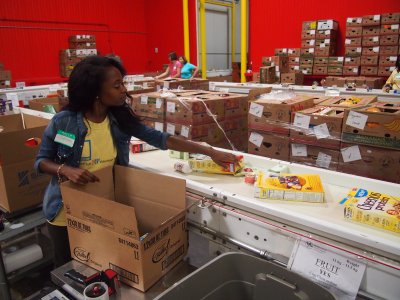
Janet Addo, 25, a first-time volunteer with the Maryland Food Bank, sorts food items for distribution in Baltimore. Sept. 30. (Photo: Madeleine List)
BALTIMORE (Oct. 1, 2014)—Sometimes, more than 16 tons is not enough.
On Tuesday, the final day of Hunger Action Month, the Maryland Food Bank, a nonprofit hunger organization, weighed a total of 33,405 pounds in donations of food and other goods from its most recent food drive. Even with the help of a “virtual food drive,” this fell shy of its goal to beat the September 2013 collection of 35,000 pounds.
The drop in donations comes at a time of rising food insecurity in a state where people are still feeling the effects of an economic recession and cuts to federal food assistance programs.
The drive included contributions from all over Maryland and food purchased with monetary donations to the food bank’s virtual food drive. The new, Internet-based donation system was launched in September to increase efficiency and reduce costs of picking up donations from collection sites, said John Shaia, vice president of programs and network relations with the Maryland Food Bank.
The virtual food drive mimics an online shopping experience and allows users to choose the items and quantities they would like to donate, and give money for them online, Shaia said. The food bank then uses the funds to buy the products, which they can often find at cheaper prices than the average shopper through bulk buying, he said.
“We’re always looking to enhance and streamline methods of sourcing food,” Shaia said. “This has the benefit of a traditional food drive, but more efficient.”
The virtual food drive received an estimated $3,000 in donations in September, said Joanna Warner, communications director at the Maryland Food Bank.
Visit the virtual food drive here: www.mdfoodbank.org/donate/virtual-food-drive/.
Need for food aid in Maryland has risen significantly partially due to last year’s funding cuts to the federal Supplemental Nutrition Assistance Program, also known as SNAP, or food stamps. The program provides food aid to families who fall below the national poverty line, which is defined by an average annual salary of $23,834 for a family of four, according the U.S. Census Bureau. A combination of cuts to this safety net and rising costs of food is leaving many people hungry, even if they’re working, Shaia said.
The Rev. Andre Samuel, director of food distribution at the Faith Tabernacle Church in Baltimore, one of the food pantries serviced by the Maryland Food Bank, said he saw a substantial increase in need over the summer and expects the number of clients to rise during the fall and winter months.
Last summer, the church’s food pantry, which is open five days a week from 9 a.m. to 5 p.m., served about 1,000 people per month, and he expects to see that number rise to 1,100 or 1,200 in the coming months due to the end of seasonal labor opportunities, he said. In past years, the church was only serving about 700 clients per month during the summer and 1,000 during the fall and winter months, he said.
This will be a difficult demand to meet when funds are tight, he added.
“People are coming in with stories saying, ‘They cut $150 out of my food stamps and they didn’t even tell me. Even if they did tell me, how would I feed my kids?’” he said.
The number of people registered in SNAP dropped in all but nine states, including Maryland, where about 12 percent of the population receives food stamps, according to the Food Research and Action Center, a national nonprofit working to reduce hunger in the U.S.
For fiscal year 2014 the benefits for Maryland were cut $82 million. Nationwide, households of four are seeing an average monthly cut of $36 to their benefits, according to the Center on Budget and Policy Priorities, a think tank focusing on government funding for poor and middle-income Americans.
About 41 percent of the food-insecure population in Maryland isn’t eligible for SNAP benefits because their incomes are too high to qualify for programs, but not high enough to cover their food needs, according to the Maryland Food Bank.
The food bank services about 40,000 to 90,000 people in this group – considered working poor – every year, Shaia said.
“They make too much to qualify for assistance, but not enough to pay bills,” he said. “These are the ones who are saying, ‘Do we get the medicine we need or do we get food?’”


